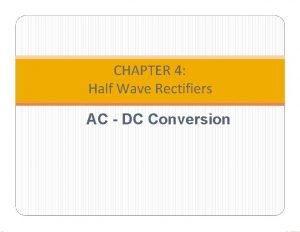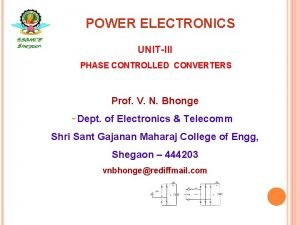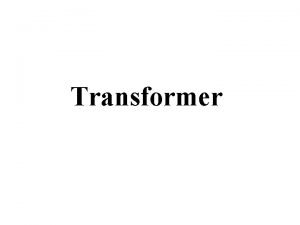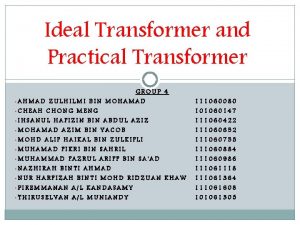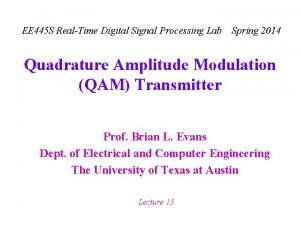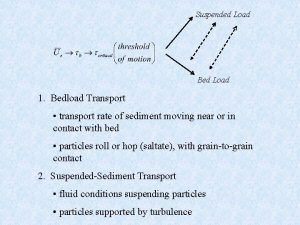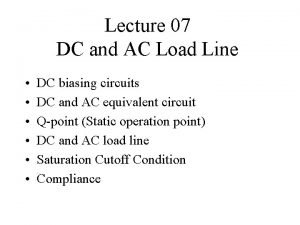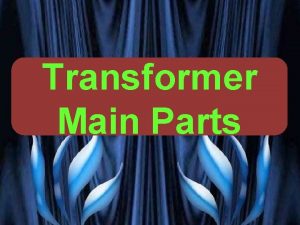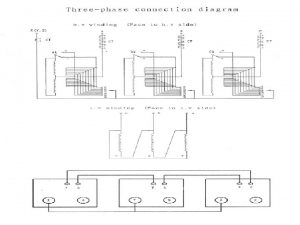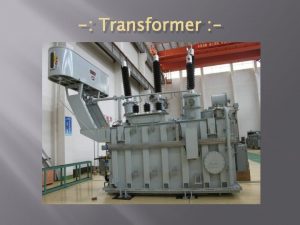Single Phase Transformer on LOAD on NO LOAD

















- Slides: 17

Single Phase Transformer on LOAD & on NO LOAD with vector diagram & approx. equivalent MODULE-IV

-: Topic covered : - • Transformer on LOAD. • Transformer on NO LOAD. • Phasor diagram. • Approximate equivalent circuit.

-: Transformer on NO Load: -

When an actual transformer is put on load, there is iron loss in the core and copper loss in the windings (both primary and secondary) and these losses are not entirely negligible. Even when the transformer is on no-load, the primary input current is not wholly reactive. The primary input current under no-load conditions has to supply (i) iron losses in the core i. e. hysteresis loss and eddy current loss and (ii) a very small amount of copper loss in primary (there being no Cu loss in secondary as it is open)

Hence, the no-load primary input current I 0 is not at 90° behind V 1 but lags it by an angle φ0 <90°. �No-load input power W 0 = V 1 I 0 cos φ0 where cos φ0 is primary power factor under noload conditions. No-load condition of an actual transformer is shown vectorially.

primary current I 0 has two components : (i) One in phase with V 1. This is known as active or working iron loss component Iw because it mainly supplies the iron loss pluss mall quantity of primary Cu loss. Iw = I 0 cosφ0 (ii) The other component is in quadrature with V 1 and is known as magnetizing component Iμ because its function is to sustain the alternating flux in the core. It is wattless. Iμ = I 0 sin φ0 Obviously, I 0 is the vector sum of Iw and Iμ, hence I 0 = (Iμ 2 + Iω2). The following points should be noted carefully.

1. The no-load primary current I 0 is very small as compared to the full-load primary current. It is about 1 per cent of the full-load current. 2. Owing to the fact that the permeability of the core varies with the instantaneous value of the exciting current, the wave of the exciting or magnetizing current is not truly sinusoidal. As such it should not be represented by a vector because only sinusoidally varying quantities are represented by rotating vectors. But, in practice, it makes no appreciable difference.

3. As I 0 is very small, the no-load primary. Cu loss is negligibly small which means that noload primary input is practically equal to the iron loss in the transformer. 4. As it is principally the core-loss which is responsible for shift in the current vector, angle φ0 is known as hysteresis angle of advance.

-: Transformer ON Load: -

When an electrical load is connected to the secondary winding of a transformer and the transformer loading is there fore greater than zero, a current flows in the Secondary winding and out to the load. This secondary Current is due to the induced secondary voltage, set up by the magnetic flux created in the core from the primary Current.

Phasor Diagram of Transformer on load INDUCTIVE LOAD

CAPACITIVE LOAD

RESISTIVE LOAD

Approximate Equivalent Circuit The approximate equivalent circuit can be obtained by shifting the exciting circuit (containing R 0 & X 0) to left of R 1 & X 1 as shown below.

Due to shifting of R 0 X 0 to the left of R 1 & X 1 there will be an error induced in the voltage drop across R 1 & X 1. Hence this circuit is called approximate equivalent circuit. But now it is possible to combine the resistive R 1 & R’ 2 and X 1 with X’ 2. So R 1 & R 2’ are combined to obtain the total primary resistance RIT. → R 1 T = R 1+R’ 2= R 1+R 2/K 2

Similarly X 1 with X 2’ can be obtain to get XIT. So the equivalent circuit can be simplified as shown in below figure. where X 1 T = X 1+X’ 2= X 1+X 2/K 2 Therefore total impedance is given by Z 1 T = R 1 T+j. X 1 T

The other component in figure R 0 = V 1/IC and X 0 = V 1/IM and IC = I 0 cosφ0 and IC=I 0 sinφ0.
 Single phase full wave uncontrolled rectifier with rl load
Single phase full wave uncontrolled rectifier with rl load Single phase ac voltage controller using triac
Single phase ac voltage controller using triac Semi converter operates in which quadrant
Semi converter operates in which quadrant Multi channel multi phase example
Multi channel multi phase example Why transformer called static device
Why transformer called static device Difference between ideal and practical transformer
Difference between ideal and practical transformer 15 degree phase shift transformer
15 degree phase shift transformer Load paths
Load paths Bed load and suspended load transport
Bed load and suspended load transport Difference between ac load line and dc load line
Difference between ac load line and dc load line Taper roller bearing advantages and disadvantages
Taper roller bearing advantages and disadvantages Line vs phase voltage
Line vs phase voltage M tswett pronunciation
M tswett pronunciation Adsorption chromatography
Adsorption chromatography Mobile phase and stationary phase
Mobile phase and stationary phase Phase to phase voltage
Phase to phase voltage Normal phase vs reverse phase chromatography
Normal phase vs reverse phase chromatography Mobile phase and stationary phase
Mobile phase and stationary phase
